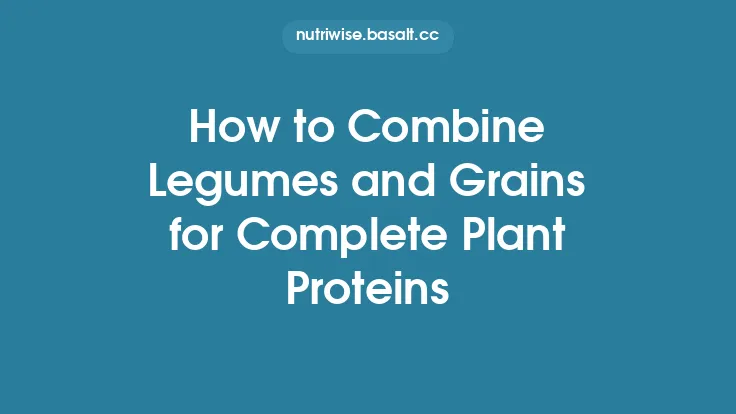Micronutrients are the tiny powerhouses that keep our bodies running smoothly—supporting everything from immune defense to cellular repair. While it’s easy to think of vitamins and minerals as isolated entities that simply need to be “eaten enough of,” the reality is far more nuanced. The way we combine foods on a plate can dramatically influence how well these micronutrients are absorbed, utilized, and retained. Understanding the science of nutrient synergy allows you to design meals that do more than just meet daily recommendations; they can actually amplify the benefits of each micronutrient, turning a good diet into a great one.
The Science Behind Micronutrient Synergy
Bioavailability vs. Total Content
The term *bioavailability* refers to the proportion of a nutrient that is digested, absorbed, and made available for use or storage in the body. A food may be rich in a particular vitamin or mineral, yet if the nutrient is locked away by other compounds, its bioavailability can be low. Synergistic food pairings work by either:
- Enhancing absorption – providing a co‑factor that unlocks a nutrient’s transport mechanisms.
- Reducing inhibitors – neutralizing compounds that bind nutrients and prevent uptake.
- Facilitating metabolic conversion – supplying enzymes or co‑enzymes that convert a nutrient into its active form.
Key Mechanisms
| Mechanism | Example | How It Works |
|---|---|---|
| Co‑factor activation | Vitamin C + non‑heme iron | Ascorbic acid reduces ferric (Fe³⁺) to ferrous (Fe²⁺) iron, the form most readily absorbed in the duodenum. |
| Lipid solubilization | Fat‑soluble vitamins (A, D, E, K) + dietary fat | These vitamins dissolve in micelles formed by bile salts only when dietary fat is present, enabling transport across the intestinal wall. |
| Enzyme co‑substrate | Vitamin B₆ + tryptophan → serotonin | Pyridoxal‑5′‑phosphate (active B₆) acts as a co‑enzyme in the conversion of tryptophan to serotonin, influencing mood regulation. |
| Inhibitor neutralization | Calcium + oxalate‑rich foods (spinach) | Calcium binds oxalate in the gut, forming insoluble calcium oxalate that is excreted, reducing oxalate absorption and kidney stone risk. |
| Microbial fermentation | Prebiotic fiber + gut microbiota → short‑chain fatty acids (SCFAs) | SCFAs improve mineral absorption (e.g., calcium, magnesium) by lowering colonic pH and increasing solubility. |
Core Micronutrient Pairings for Maximum Absorption
Below is a practical “pairing cheat‑sheet” that you can keep in your kitchen drawer. Each combination is supported by peer‑reviewed research and can be incorporated into everyday meals without drastic changes to taste or preparation.
| Nutrient to Enhance | Ideal Partner(s) | Reason for Synergy |
|---|---|---|
| Non‑heme iron (found in legumes, leafy greens, fortified grains) | Vitamin C‑rich foods: citrus, strawberries, bell peppers, broccoli | Vitamin C reduces Fe³⁺ to Fe²⁺ and forms a soluble complex that resists inhibition by phytates. |
| Beta‑carotene (pro‑vitamin A) | Dietary fat: olive oil, avocado, nuts, seeds | Fat emulsifies beta‑carotene, allowing incorporation into micelles for absorption. |
| Vitamin D | Magnesium‑rich foods: pumpkin seeds, almonds, black beans | Magnesium is a co‑factor for the enzymatic activation of vitamin D into its hormonal form (calcitriol). |
| Calcium | Vitamin K₂ (found in fermented soy, natto) | Vitamin K₂ directs calcium to bones and teeth, reducing arterial deposition. |
| Zinc | Protein (especially animal protein) | Amino acids, particularly cysteine and methionine, form complexes that improve zinc solubility and uptake. |
| Folate | Vitamin B₁₂ | Together they support the methylation cycle; deficiency in one can mask the other's deficiency symptoms. |
| Selenium | Vitamin E | Vitamin E protects selenium‑containing enzymes (e.g., glutathione peroxidase) from oxidative damage, enhancing their activity. |
| Magnesium | Vitamin B₆ | B₆ improves magnesium transport across cell membranes and supports enzymatic reactions that require magnesium. |
| Potassium | Vitamin C | Vitamin C reduces urinary loss of potassium by modulating renal reabsorption pathways. |
Managing Antinutrients: Turning “Bad” into “Better”
Many plant foods contain compounds that can bind minerals and lower their bioavailability. Rather than avoiding these foods, you can employ simple culinary techniques to mitigate their impact.
| Antinutrient | Common Sources | Mitigation Strategy | Effect on Micronutrient Synergy |
|---|---|---|---|
| Phytate (phytic acid) | Whole grains, legumes, nuts, seeds | Soak (6–12 h) in warm water, add a splash of acidic medium (lemon juice or vinegar), then rinse; sprout or ferment. | Releases bound iron, zinc, calcium, and magnesium, making them more absorbable. |
| Oxalate | Spinach, beet greens, rhubarb, nuts | Pair with calcium‑rich foods; boil briefly and discard water (water‑soluble oxalates leach out). | Reduces oxalate absorption, freeing calcium for bone health. |
| Polyphenols (tannins) | Tea, coffee, cocoa, some legumes | Consume polyphenol‑rich beverages between meals rather than with meals; add a small amount of milk (casein binds tannins). | Lessens inhibition of iron and zinc absorption. |
| Goitrogens | Cruciferous vegetables (broccoli, kale) | Lightly steam (2–3 min) to inactivate the enzyme myrosinase that converts glucosinolates to goitrogenic compounds. | Preserves iodine utilization for thyroid hormone synthesis. |
| Lectins | Raw beans, lentils, peanuts | Soak and cook thoroughly (boil for ≥10 min) to denature lectins. | Prevents gut irritation and improves protein and mineral absorption. |
Cooking Methods that Boost Micronutrient Synergy
- Gentle Steaming – Preserves water‑soluble vitamins (C, B‑complex) while softening cell walls, allowing better release of fat‑soluble vitamins when paired with a drizzle of oil.
- Sautéing in Healthy Fats – A quick sauté of leafy greens in olive oil not only adds the necessary lipid for carotenoid absorption but also creates a flavorful matrix that encourages higher vegetable intake.
- Fermentation – Fermented foods (kimchi, sauerkraut, tempeh) increase the bioavailability of B‑vitamins and minerals by breaking down phytates and producing organic acids that improve mineral solubility.
- Roasting with Acidic Marinades – Marinating root vegetables in lemon juice or vinegar before roasting can lower phytic acid content and simultaneously add vitamin C for iron absorption.
- Blanching Followed by Cold Shock – For cruciferous vegetables, blanching deactivates goitrogenic enzymes, while the rapid cooling preserves texture and color, making them more appealing for mixed salads.
Timing and Sequence: When to Eat What
The order in which foods are consumed can influence nutrient interactions, especially when dealing with competitive absorption pathways.
| Scenario | Recommended Sequence | Rationale |
|---|---|---|
| Iron‑rich meal | Start with vitamin C‑rich fruit or a glass of orange juice, then consume iron‑containing foods. | Vitamin C pre‑loads the gut lumen, maintaining a reducing environment for iron. |
| Calcium‑rich dinner | Include a small serving of leafy greens (high in oxalate) after the calcium source, not together. | Calcium binds oxalate when consumed simultaneously, reducing oxalate absorption. |
| High‑fiber breakfast | Pair whole‑grain toast with a protein source (e.g., eggs) and a modest amount of healthy fat (e.g., avocado). | Protein and fat counteract the mineral‑binding effect of soluble fiber, preserving zinc and iron uptake. |
| Post‑exercise recovery | Combine a carbohydrate‑rich snack with a protein source and a small amount of fruit (vitamin C) within 30 min. | Enhances glycogen replenishment, muscle repair, and iron absorption needed for hemoglobin synthesis. |
Practical Meal‑Building Framework
To translate the science into everyday cooking, adopt a “Synergy‑First” mindset when constructing meals:
- Identify the Micronutrient Goal – Choose a target (e.g., boost iron, improve vitamin A status).
- Select a Primary Food Source – Pick the food richest in that nutrient (e.g., lentils for iron).
- Add a Proven Enhancer – Pair with a complementary food (e.g., bell pepper for vitamin C).
- Incorporate a Healthy Fat – If the target nutrient is fat‑soluble or carotenoid‑based, drizzle olive oil or add avocado.
- Mind the Inhibitors – If the primary source also contains antinutrients, apply a mitigation step (soak, sprout, cook).
- Balance the Plate – Ensure protein, complex carbs, and fiber are present to support overall digestion and satiety.
Example: Iron‑Boosting Lunch
- Base: Warm lentil salad (non‑heme iron).
- Enhancer: Fresh diced red bell pepper and a squeeze of lemon juice (vitamin C).
- Fat: A tablespoon of extra‑virgin olive oil mixed into the dressing.
- Mitigation: Lentils soaked overnight, then boiled to reduce phytate content.
- Balance: Add a handful of pumpkin seeds (zinc, magnesium) and a side of mixed greens for additional micronutrients.
Special Considerations for Different Populations
| Population | Micronutrient Synergy Focus | Practical Tips |
|---|---|---|
| Pregnant individuals | Folate + vitamin B₁₂ + iron | Combine leafy greens (folate) with citrus (vitamin C) and lean meat (heme iron) for optimal fetal development. |
| Older adults | Vitamin D + calcium + magnesium | Pair fortified dairy (vitamin D) with nuts/seeds (magnesium) and a drizzle of fish oil (healthy fat) to support bone health. |
| Vegans | Vitamin B₁₂ + iron + zinc | Use fortified plant milks (B₁₂) with legumes (iron) and nuts (zinc), and add fermented tempeh to improve mineral bioavailability. |
| Athletes | Iron + vitamin C + electrolytes | Include a post‑workout smoothie with spinach, kiwi, and a pinch of sea salt to replenish iron stores and electrolytes. |
| Individuals with gastrointestinal disorders | Fat‑soluble vitamins + probiotics | Pair small amounts of fat (e.g., coconut oil) with fermented foods (kimchi) to aid absorption of vitamins A, D, E, K. |
Monitoring and Adjusting Your Synergy Strategy
- Track Food Pairings – Use a simple spreadsheet or nutrition app to note which foods you combine and any perceived changes in energy, digestion, or skin health.
- Blood Biomarkers – Periodic lab tests (e.g., ferritin, 25‑OH vitamin D, serum zinc) can confirm whether your synergistic meals are translating into improved status.
- Iterative Tweaking – If a particular nutrient remains low, revisit the pairing matrix: perhaps the inhibitor load is still high, or the enhancer quantity needs boosting.
- Seasonal Rotation – While the article avoids a “seasonal superfoods” focus, rotating produce ensures a broader spectrum of phytonutrients that can act as secondary enhancers (e.g., flavonoids that improve vascular health, indirectly supporting nutrient transport).
Quick Reference: 10 Go‑to Synergistic Combos
| # | Combo | Primary Benefit |
|---|---|---|
| 1 | Spinach + citrus vinaigrette | Vitamin C ↑ non‑heme iron absorption |
| 2 | Carrots + hummus (tahini + olive oil) | Fat ↑ beta‑carotene uptake |
| 3 | Salmon + avocado | Omega‑3s + healthy fat boost vitamin D utilization |
| 4 | Greek yogurt + berries | Calcium + vitamin C improves calcium retention |
| 5 | Quinoa + pumpkin seeds + lemon zest | Magnesium + zinc + vitamin C for enhanced mineral uptake |
| 6 | Miso soup with seaweed + tofu | Fermentation + calcium from seaweed improves calcium bioavailability |
| 7 | Broccoli + almond slivers | Vitamin K + magnesium for bone health synergy |
| 8 | Lentil stew with tomatoes | Iron + vitamin C for better iron status |
| 9 | Whole‑grain toast with almond butter + sliced banana | Vitamin E + magnesium + potassium for cardiovascular support |
| 10 | Kefir smoothie with spinach, kiwi, and flaxseed | Probiotics + vitamin C + omega‑3s enhance overall micronutrient absorption |
Closing Thoughts
Micronutrient synergy transforms the act of eating from a simple tally of “how many vitamins and minerals?” into a strategic, science‑backed approach that maximizes the functional value of every bite. By consciously pairing foods that complement each other, neutralizing antinutrients through simple preparation methods, and timing meals to favor optimal absorption, you can unlock a higher tier of nutritional performance—one that supports long‑term health, energy, and resilience.
Remember, the goal isn’t to overhaul your diet overnight but to embed a few key pairings into your regular cooking routine. Over time, these small adjustments compound, delivering a diet that not only meets but *exceeds* your micronutrient needs through natural, delicious synergy. Happy combining!





